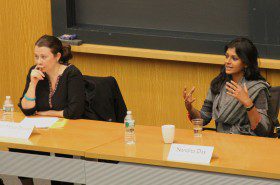This article originally appeared in the Harvard Arts Blog.
By Brenna McDuffie, Harvard College ’15
On Friday, Sept. 19, the Harvard South Asia Institute inaugurated its Arts Initiative with a seminar that explored the role of arts in social change. Cara Moyer-Duncan, assistant professor of African studies at Emerson College, and Indian actress Nandita Das, whose extensive work in the Indian art film industry has gained her critical acclaim (Fire 1996, Earth 1998, Firaaq 2008) discussed the use of cinema in Africa and South Asia as a tool for social activism.
The panel was moderated by Mukti Khaire, associate professor of business administration at Harvard Business School. The event was co-sponsored by the Cultural Agents Initiative, Harvard Humanitarian Initiative and the Cultural and Humanitarian Agents seminar at the Mahindra Center for the Humanities.
Das explained why she has devoted her life’s work to art cinema rather than commercial Bollywood film. “Art has a way of getting into our subconscious in ways that we are not aware of,” said Das.
Das and Moyer-Duncan went on to discuss the ability of art cinema and documentary film to comment on and engage radically with societal issues in Africa and South Asia, including issues of female incision and slum eviction in Africa and homosexuality and domestic violence in India.
Das cited her first popular role in an art film as a prime example of cinema as a platform for difficult social issues. In 1996, the young Das starred in Deepa Mehta’s film Fire, which was released in India in 1998. The film narrates the story of Sita (Das) and her mother-in-law Radha, whose relationship takes a romantic turn while their husbands ignore their emotional needs.
Fire was one of the first widely circulated Indian films to explicitly address and show homosexual relations, and it sparked several protests against and discussions about homosexuality upon its release.
“People ask, ‘How were you really ready for this film?’ and I think: How do you know when you’re ready? Does a bell go off?” said Das. “See, I think it’s always too late. We are always ready for any kind of thing that makes us a little too honest, that shakes a few things and makes us look at our double standards and hypocrisies upfront,” Das said.
Meena Hewett, Executive Director of SAI, voiced a point that resurfaced throughout the evening. “In South Asia, art is a very rich part of history, and we often use art to talk about difficult issues, but a lot of people don’t know how to manage and distribute it,” she said.
Both Moyer-Duncan and Das commented on the difficulty to distribute the independent films that address social issues among the masses in Africa and India. Moyer-Duncan pointed out that many movie theaters in Africa are still controlled by Europe, and therefore, Hollywood (and sometimes Bollywood) films receive much of the screen time.
Das noted a similiar issue in India, where the Megaplex cinemas that reach the masses in urban areas will not reserve even their smallest screens for independent films. Increasing visibility for socially relevant art and artists is one of the SAI goals in starting their Arts Initiative.
“Bringing people together is part of what the SAI does as an umbrella organization, and we want to consider how Harvard can be a resource for bringing administrators and artists together,” Hewett said of the new Arts Initiative. “We want to foster exchange between artists and scholars and explore how art can be used as a medium to communicate social issues.”

